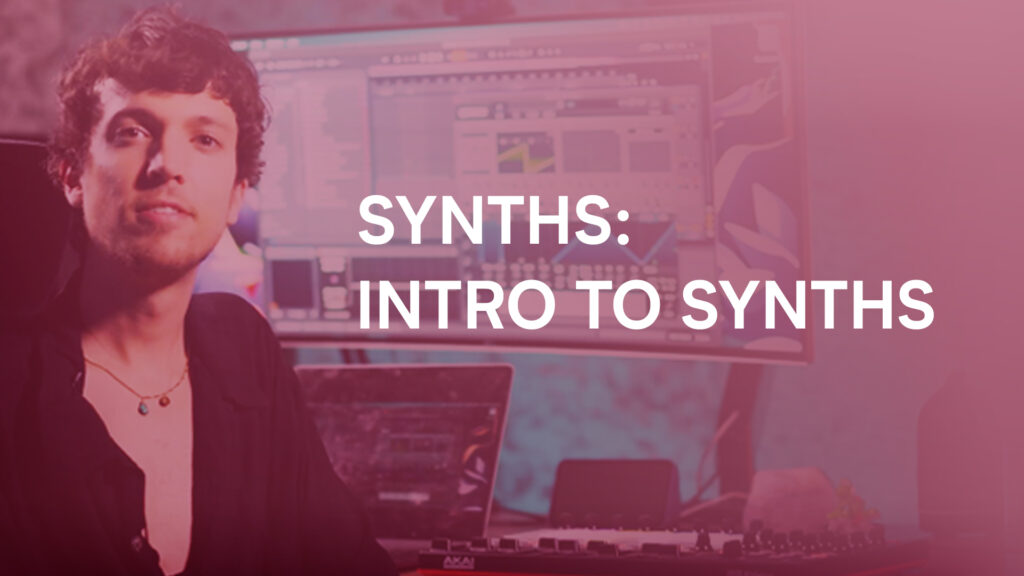Course content
Eric talks us through the fundamentals of sound and how synthesizers interact with each of the different aspects to sound. Breaking sound down into its three components, (pitch, timbre, amplitude), he dives into Serum showing how you can manipulate sounds for various case purposes. Furthermore, he takes us through the signal flow of synthesizers showcasing the building blocks of synthesis one by one. Producers utilizing not just serum but any synthesizer can find insight into the science of sound and synthesizers.
Starting with the concept of pitch in sound, Eric walks through the different pitch manipulation components in Serum. He discusses a wide range of features available not only in serum, but generally in synthesizers that producers can use to alter pitch to create unique sounds and textures. Producers looking to expand their knowledge of pitch and sound as well as their application of sound design can find great insight in this tutorial.
In this lesson, Eric runs through the different basic shapes of oscillators in synthesis. He walks through each individually breaking down their unique characteristics and common use cases. Further into the video, Eric demonstrates the waves one after another with melody lines, basslines, and chords so listeners can compare the sonic qualities of each wave. Producers can find great value in understanding the basic principles of oscillators and synthesis with this tutorial.
In part one of this two part series, Eric begins his walk through of synthesizer filters covering the functionality of the cutoff and resonance knobs. He explains the use cases of these aspects of a filter and provides examples on how they can manipulate sounds to achieve certain effects. Producers looking to expand their arsenal of synthesis and understanding of filters can get a good foundation with this tutorial.
In the second part of this series, Eric covers the different types of basic filter shapes. He discusses the four central filters common to synths universally (low pass, high pass, band pass, notch) and one-by-one goes through an in-depth explanation of each one. After a look through how the filters affect the sound, Eric demonstrates each filter on different types of sounds so the audience can better understand the applications of each filter shape. Producers looking to employ more intricate uses of synthesis filters can find great value in this tutorial.
For the first of three parts to the Envelopes series, Eric walks through the basic parameters of synthesizer envelopes. Covering ADSR (attack, decay, sustain, release) functionality one-by-one, Eric explains how each aspect of the envelope affects the sound. He shows further examples of sounds with different settings of the envelope parameters so listeners can get a better understanding of the impact envelopes have on sound. Producers looking to get better at sculpting their sounds in any synthesizer can find great value in understanding envelopes via this tutorial.
Building off his explanation of Envelopes in part one, Eric now shows us how different envelope shapes affect the articulation and character of sound. Using various combinations of ADSR settings, Eric shows how different permutations of envelope parameters produce different articulations of sound. Furthermore, Eric walks through how to map midi controller knobs to envelope parameters so producers can get a more real-time feel for manipulating the character of sound. Producers looking to understand more regarding sonic articulation and how to better utilize midi controllers in their sound design repertoire can find great value in this tutorial.
In the last part of the envelopes series, Eric takes us through the basics of envelope modulations. He shows the effect of different envelope settings for different characters of sound (pads, leads, plucks) as well as how envelopes can modulate parameters such as pitch and volume to achieve more unique sounds. Producers looking to delve into a greater complexity of sound design capabilities can find lots of value with understanding the fundamentals of envelope modulation.
For part one of the LFO series, Eric takes us through Serum to explain the fundamentals behind LFO and their capabilities when it comes to manipulating sound. He discusses different uses cases for LFO’s as well as providing examples of sounds they can achieve via different methods of application. Producers looking to widen their arsenal of sound design tools can find great use in learning the basics of LFO’s with this lesson.
For part two of the LFO series, Eric dives deeper into the different modulation abilities of LFO’s. He provides insight into BPM based modulation of sound explaining the different methods of timing LFO modulation as well as showing examples of LFO use for different rhythmic and creative effects. Producers looking to expand their range of LFO capabilities can find value in learning more nuanced and unique ways to utilize this tool.
In Part One of this three part series, Eric covers the fundamentals of modulation features native to any synth. Working in Serum, Eric discusses how to utilize envelopes and LFOs on certain oscillator and filter parameters to sculpt the sound in different ways. Producers looking to explore more advanced means of achieving unique sounds can add modulation tools to their arsenal for success.
In Part Two of this three part series, Eric applies modulation to a greater level of complexity. Initially Eric starts with layering modulations to create a sound while also diving into tools such as the warp knob to add more tools to use. Lastly, Eric demonstrates how modulations can be stacked one after another via some examples to show producers how complex and experimental sounds can be using the modulation tricks and tips he shares. Producers looking to perform more advanced modulation tricks on their sounds can find great benefit in these videos.
In the last part of this series, Eric explores auxiliary modulation and vibrato techniques. He shows how envelopes and LFOs can be used as modulators to an existing modulation envelope or LFO. Likewise, he also shows how this can be used within the context of vibrato offering producers the ability to emulate a human like feel to their music. Lastly, Eric takes all the elements of the three part modulation series together and experiments with applying all the advanced modulation techniques to achieve unique sounds. Producers interested in advanced level sound design methods can find a lot of use in understanding auxiliary and vibrato modulation.
For Part One of the Alternate Methods series, Eric looks at monophonic versus polyphonic voices and their different use cases as well as character. Furthermore, Eric takes polyphonic voicing one step further by demonstrating unison detuned voicing on different types of sounds in serum. Producers looking to expand their ability to develop unique characters to sounds can find great value in this tutorial.
For Part Two of the Alternate Methods series, Eric uncovers the velocity parameter in serum and how to achieve different dynamics within a melody or chord purely within the serum controls. Likewise, he also discusses how to use serum’s mod wheel and pitch bend wheel to effect as well as provides some nice examples of how the wheels can take a sound to the next level. Producers utilizing all synths can find great use in better understanding how to create more dynamic capabilities in their sound design via this tutorial.
In the final part of the Alternate Methods series, Eric goes over what Portamento is and how it can be used as well as explaining certain trademark sounds that utilize portamento. Furthermore, Eric discusses how alternative macros in Serum can be used by producers for greater control over sculpting sounds. Producers looking to add a little more tools to their sound design belt can find great benefit in these simple yet effective techniques native to synths of all kinds.
Starting off this three part series, Eric takes a look at how simple oscillator adjustments can go a long way in taking sounds to the next level. He varies between examples of oscillator volume and tuning manipulation and then ties it all together with a demonstration of how these moves can create very unique sounds. Producers looking to better harness the full utility of their synths can find great value in this video.
On the second video of the three part series, Eric dives into arpeggio techniques native to most synths and available externally in ableton via a native plugin. He provides a basic understanding of arpeggios and then explains how musically they can add a new perspective to the song allowing for enhanced sound design and synthesis capabilities when matched with traditional synthesis techniques. Producers looking to expand their knowledge of harmony and its relation to synthesis and sound design can find great benefit with this video.
In the last of this three part series, Eric uses ableton’s built in wavetable synthesizer to create new sounds to his on-going creation of a song in this series. Furthermore, he dives into serum to uncover the different warp modes on oscillators producers can utilize to add more movement to their sounds. This tutorial is great for producers looking to apply their synthesis knowledge to ableton native synths as well as experiment to a greater level with oscillators using warp modes.
For part one of Advanced Synthesis, Eric takes us through an introduction to FM synthesis. Featuring Serum and Ableton’s operator in this video, Eric provides an overview of what FM synthesis is, how to utilize it within common synthesizers, and examples of the sound within the context of a song. Producers looking to step beyond subtractive synthesis into greater levels of complexity with their sound design can find great benefit with this video.
For part two of Advanced Synthesis, Eric moves onto Granular Synthesis. Working with Ableton’s stock granular synthesizer, Eric demonstrates how to drag in audio samples into the synthesizer and start manipulating the sound via the parameters commonly available on most granular synthesizers. He then incorporates granular synthesis into a live demonstration of a song. Producers looking to expand their sound design repertoire would find great results with learning granular synthesis from this tutorial.
In this lesson, you'll learn the fundamentals of wavetable synthesis and how to incorporate this unique method of synthesis into your sound design.
In the first of this two part series, Eric uses Serum to recreate Lost Capital’s “Livin’ Without Maybes” and uncovers the different sound design elements present in the song. He dives into Serum to show how the song was constructed and explains the reasoning behind synthesis decisions in the song.
In the last of this two part series, Eric recreates sounds of Gummibear’s track “Snack Machine” and uncovers the different sound design elements present in the song. He dives into Serum to show how the song was constructed and explains the reasoning behind synthesis decisions in the song.

Eric talks us through the fundamentals of sound and how synthesizers interact with each of the different aspects to sound. Breaking sound down into its three components, (pitch, timbre, amplitude), he dives into Serum showing how you can manipulate sounds for various case purposes. Furthermore, he takes us through the signal flow of synthesizers showcasing the building blocks of synthesis one by one. Producers utilizing not just serum but any synthesizer can find insight into the science of sound and synthesizers.
